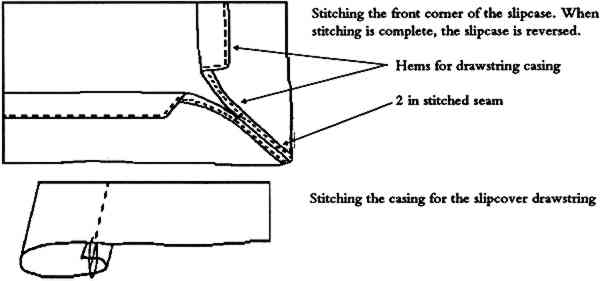HISTORIC UPHOLSTERY: A NEW PERSPECTIVE ON TREATMENTELIZABETH LAHIKAINEN
5 TREATMENT5.1 TRADITIONAL METHODSFor some objects, traditional upholstery methods might be considered appropriate. A mid-19th-century piece, for example, may need traditional methods of attachment, such as relashing or support lashing of the springs, to keep all the materials together. New rows of stitching may be needed to support or reattach two or three layers of original stuffings. Traditional techniques can be a successful as well as convenient process in stabilizing upholstery materials. These methods, however, typically cause a great disturbance to the original fabric of the object and should be considered only after establishing that less intrusive methods will not reach the goals of the treatment. A new loose slipcover of a good reproduction fabric constructed using period methods can be an afforable solution and can cover a multiptude of sins. Figure 1 demonstrates how a new tight slipcase might work for a slip seat of a side chair.
5.2 METHODS THAT USE FEW METAL FASTENERS: A FEW SOLUTIONS5.2.1 High-Density Expanded FoamsWhen the frame retains no upholstery layers, it is possible to construct an underupholstery from an alternative material. A high-density foam such as Ethafoam (expanded 5.2.2 Drop-In SeatsPlastic materials are not always suitable for use in seats because they are so hard. For comfort of a seat that is still being used, traditional materials are often required. A new seat frame can be constructed to fit inside the original frame so it is structurally sound enough to hold the weight of the sitter. Faced with a liner, it will not rub or bruise the period frame. The new frame can be used to hold the traditional materials of webbing, stuffing, and the hundreds of tacks required to secure the various materials of the reupholstery, but the period materials remain undisturbed. Figure 2 demonstrates how new materials can be used to hold upholstery layers and protect the artifact.
5.2.3 Caps and ApronsMany artifacts have endured losses to their wood edges from numerous tacks being applied and removed during successive reupholsteries. It is possible to face these edges with a ridged support rather than execute extensive replacement to the wood to regain strength and a proper form. These “aprons” of various materials, such as sheet polyethylene or thin sheet copper, can be covered with fabric so they have a sewing edge for the attachment of the finish cover or trim. The additional layers can also be adhered to the new support with a suitable adhesive. These aprons can be secured to a new seat frame, or they can be screwed into Ethafoam or possibly minimally stapled to the artifact, depending upon the needs of individual project. This method is especially useful in treating a piece where the upholstery goes half over the rail and finished show wood prevents wrapping the fabric around the rail. Aprons can easily become part of other noninterventive upholstery systems such as “caps.” The support system for the seating area can be constructed out of thin sheet copper or cast from man-made polymers and used as the base of the upholstered area. The cap is then built up with textile layers to complete the form. Figure 3 demonstrates how new materials can be used to fabricate an upholstered area that is entirely separate from the furniture. Figure 4 shows the end result of alternative upholstery methods on a period frame. The decorative brass nailheads are gluded on rather than driven into the frame.
5.2.4 AdhesivesAdhesives seem to be an obvious solution to holding materials in place where metal fasteners are undesirable. However, keeping the adhesive contained to the new materials while providing a clean line to the form of the object is a challenge. Heat-sensitive sheet adhesive like Beva film set onto materials that can maintain the characteristics of being thin, strong, and stiff, such as Nomex (a Du Pont polyamide product), can be used in the tacking margin to hold the finish fabric. The Nomex is heat set to the sheet adhesive (adhesive side up) and then laid onto the tacking margin and attached to the wood using a minimal number of metal 5.3 TEXTILE CONSERVATIONWhen original upholstery materials remain on the piece, some kind of textile conservation is usually required. It is important to preserve the under-upholstery layers with the same respect as the finish fabrics because of their importance as documents. 5.4 TEXTILE SOLUTIONSThe various elements in finish covers and trims required for historical accuracy in the reinterpretation can be prohibitively expensive to execute by traditional methods. An elaborate Chinese embroidery, for example, might cost thousands of dollars to reproduce. It might, however, be possible to capture the appropriate aesthetic using a different and more affordable technique such as silk-screening the design. The assistance of local craftspeople and artists to reproduce some of the delicate |



